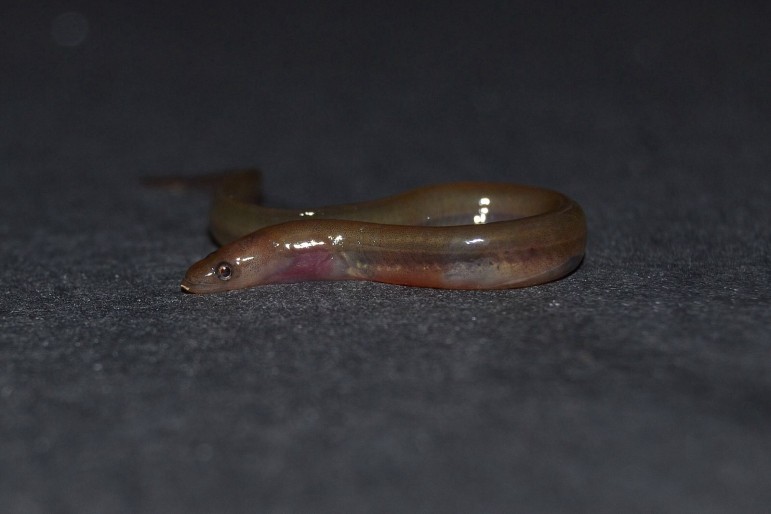
The American eel, found on the eastern coast of North America, grows up to 20 inches long. Image: Flickr, Alex Roukis
By Ali Pechulano
Electrical power plants at some eastern Ontario dams are killing American eels that are already threatened by overfishing, a recent study revealed.
The study, published by the American Fisheries Society in one of its symposium series, Managing the Impact of Human Activities on Fish Habitat: the Governance, Practices and Science in June 2015, looked at eels in the Upper St. Lawrence River, Ottawa River and Lake Ontario watersheds in eastern Ontario.
It examined the cumulative effects of hydroelectric dams on the eels and projected that only 2.8 out of every 100 eels would survive passing through them as they traveled through the Mississippi and Ottawa rivers to the Upper St. Lawrence River.
“As the eels go through each hydroelectric dam, there is a mortality effect,” said John Casselman, one of the authors of the research and adjunct professor at Queen’s University’s department of biology in Kingston, Ontario.
The deaths from hydroelectric dams have led to closing commercial eel fisheries in Ontario.
The Committee on the Status of Endangered Wildlife in Canada declared American eels to be endangered in 2012. That same year, the Atlantic States Marine Fisheries Commission, which is a commission of U.S. states formed to coordinate and manage fishery resources along the Atlantic coast of the United States, said the species was depleted. Since then, there have been no efforts made to recover the species, said Casselman
In the U.S., the American eel has not been listed as threatened, although the Council for Endangered Species Act Reliability, a California-based nonprofit environmental advocacy group now known as the Center for Environmental Science, Accuracy & Reliability, petitioned the U.S. Fish and Wildlife Service in 2010 for that status.
The Fish and Wildlife Service recently said the population does not need protection under the Endangered Species Act, but it called for continuous conservation efforts.
But some conservationists say that’s not good enough.
“The status of the American eel in the U.S. is as it is because it is politically motivated,” said Rob MacGregor, a retired assistant director of the Fish and Wildlife Branch of the Ontario Ministry of Natural Resources and a leading author of the study.
“It requires action by power companies that generate a lot of revenues,” MacGregor said.
“There has also been a lot of pushback from commercial fishing groups because of the lucrative value of the eel.”
Casselman agreed that there is a political problem regarding the status of the eel in the U.S.
“Most of the tiny larvae of the American eel, known as glass eels, are now being exported from the U.S. and the Atlantic Seaboard of Canada,” he said. “So long as that fishery exists, people don’t want them classified as threatened or endangered.”
The study attributes the decline of the eel to legislative tools and policies about fish that are neither implemented nor enforced.
The Canadian government requires free passage for fish, something the eels lack, Casselman said.
“Somebody needs to make sure these eels have passage through the turbines, upstream and downstream,” he said.
Payback time
The researchers acknowledged that it would be difficult to recover the eels that have been killed in the past decades. Yet something needs to be done.
“We have produced cheap power for 50 years in the St. Lawrence River system on the backs of the American eel,” Casselman said. “ We need to pay back the American eel now.”
“Its decline tells us that we are not treating our freshwater and its inhabitants in an appropriate way,” Casselman said
MacGregor said that resources were not dedicated to eel conservation in the 1980s, stressing that this is the time to invest in eels because of its protein and fat values.
“We need to find the right balance, and recognize that water-generated power causes a lot of environmental effects,” he said.
Casselman said that both fish and waterpower are sustainable resources.
“One sustainable natural resource has in fact jeopardized the other sustainable natural resource,” he said. “And in the long run, we need power, but we also need to eat.”
The New York Power Authority has tried to develop a passage for eels on the St. Lawrence, he said. It has created an eel-passage facility that has two major components — an eel ladder to allow eels to ascend the Robert Moses Power Dam and an eel-release system to allow them to move from the top of the ladder to a release point approximately 930 feet upstream.
The recovery of the American eel requires help from indigenous people who have an intimate knowledge of where the eels are found, the study said.
Early missionary writings tell how Native Americans caught thousands of eels in elaborate weirs, smoked them and used them for food while traveling.
While addressing the 1,021st Meeting of the Brodie Club at the University of Toronto in 2008, Casselman said that eels were a vital food for Aboriginal peoples and early European settlers because their high protein and fat levels. They contain six times the caloric value of normal fish and can be smoked for use through the winter. The Iroquois lived on eels as early as 1100.
For a species that has lived for 125 million years, “losing our association with it will be critical,” Cassselman said. “We need to respect the First Nation people’s quote about the St. Lawrence River Iroquois which says ‘eels allow people to live when all else fail.’”
Institutions participating in the study were the Ontario Ministry of Natural Resources, ESSA Technologies, Queen’s University, Skylark Information, Shabot Obadjiwan First Nation Ambassador and Plenty Canada, Heritage One and the Great Lakes Fisheries Commission.